Introduction
The results reported in the July 2022 bank lending survey (BLS) relate to changes observed during the second quarter of 2022 and expectations for the third quarter of 2022. The survey was conducted between 10 and 28 June 2022. A total of 153 banks were surveyed in this round, with a response rate of 100%. In addition to results for the euro area as a whole, this report also contains results for the four largest euro area countries.[1]
A number of ad hoc questions were included in the July 2022 survey. They address the impact of the situation in financial markets on banks’ access to retail and wholesale funding, the impact of banks’ non-performing loan (NPL) ratios on their lending policies, and the change in bank lending conditions and loan demand across the main economic sectors.
1 Overview of results
In the July 2022 BLS, euro area banks indicated a considerable further tightening of their credit standards for loans to firms in the second quarter of 2022, i.e. the percentage share of banks reporting a tightening of credit standards was considerably larger than the share of banks reporting an easing. Banks reported that risk perceptions related to the economic outlook, industry or firm-specific situation and banks’ decreased risk tolerance had a strong tightening impact on credit standards. Banks’ cost of funds and balance sheet constraints had a tightening impact on credit standards for loans to firms, as monetary policy is becoming less accommodative. In the third quarter of 2022, euro area banks expect a net tightening of credit standards for loans to firms of a similar magnitude to the second quarter.
Firms’ net demand for loans continued to increase in the second quarter of 2022, in line with expectations in the previous quarter. Loan demand continued to be driven by firms’ financing needs for working capital, likely related to increased production input prices in the context of continuing supply chain disruptions and high energy prices. At the same time, fixed investment had a dampening impact on firms’ net demand for loans, suggesting that they are postponing their investment in the current uncertain environment. In addition, the positive contribution of the general level of interest rates to loan demand was more moderate than in the previous quarter. In the third quarter of 2022, banks expect a moderate net decline in demand for loans to firms.
Banks reported a strong net tightening of credit standards for housing loans and a moderate net tightening for consumer credit in the second quarter of 2022. The net tightening of credit standards for housing loans was considerably stronger than in the previous quarter and above the historical average. For housing loans, higher risk perceptions, lower risk tolerance and a moderate tightening impact from banks’ cost of funds and balance sheet constraints contributed to the net tightening. Higher risk perceptions also primarily contributed to the net tightening of credit standards on loans for consumer credit. Loan demand from households decreased in net terms for loans for house purchase and continued to increase in net terms for consumer credit in the second quarter of 2022. Lower consumer confidence and the general level of interest rates contributed negatively to demand for both categories, while durable goods consumption contributed to the net increase in consumer credit demand. In the third quarter of 2022, banks expect a net tightening of credit standards for all lending to households. In addition, banks expect a strong net decrease in housing loan demand and broadly unchanged demand for consumer credit.
In more detail, euro area banks tightened their credit standards (i.e. banks’ internal guidelines or loan approval criteria) considerably further for loans or credit lines to enterprises in the second quarter of 2022 (net percentage of banks of 16%, after 6% in the first quarter of 2022; see Section 2.1). Risks related to the economic outlook and the industry or firm-specific situation had a considerable further tightening impact on credit standards in the second quarter of 2022. In the current environment of high uncertainty, banks’ risk tolerance declined, contributing to a tightening impact on credit standards. Banks’ cost of funds and balance sheet constraints had a small tightening impact on credit standards for loans to euro area firms, as monetary policy is becoming less accommodative. In the third quarter of 2022, euro area banks expect a net tightening of credit standards on loans to firms of a similar magnitude to that in the second quarter (18%).
In the second quarter of 2022, euro area banks reported a strong net tightening of credit standards for housing loans (net percentage of banks of 24%, after 2% in the first quarter of 2022; see Section 2.2), and a moderate net tightening for consumer credit and other lending to households (9%, after -5%; see Section 2.3), both stronger than anticipated in the previous quarter. The net tightening for housing loans was driven mainly by higher risk perceptions, lower risk tolerance and some country-specific factors. Banks’ cost of funds and balance sheet constraints had a moderate tightening impact, while competition was the only factor that had a slight easing impact. For consumer credit, increased risk perceptions mainly contributed to the net tightening. Banks expect credit standards to continue tightening for both housing loans (24%) and for consumer credit (13%) in the third quarter of 2022.
Banks’ overall terms and conditions (i.e. banks’ actual terms and conditions agreed in the loan contract) for new loans to enterprises tightened in the second quarter of 2022 (net percentage of 12%, after 3%). This tightening of terms and conditions, in the context of monetary policy normalisation, was mainly on account of a considerable widening of margins on riskier loans (net percentage of 16%; margins defined as the spread over relevant market reference rates), while the widening of margins on average loans (net percentage of 6%) and collateral requirements (net percentage of 5%) had a more moderate contribution. Banks also reported a net tightening of overall terms and conditions for both housing loans (net percentage of 22%, after 6%) and consumer credit and other lending to households (11%, after -2%). Despite the net tightening of terms and conditions, loan margins narrowed for both loans for house purchase and for consumer credit, partly reflecting the fact that market reference rates relevant for banks’ funding costs increased more than interest rates for loans to households.
In the second quarter of 2022, banks reported broadly no change in the share of rejected applications for loans to firms (net percentage of 1%, after 4%). For housing loans, euro area banks reported a significant net increase in the share of rejected applications (28%, after 1%). This is the largest net increase in the share of rejected applications since the series began in the first quarter of 2015. The share of rejected applications increased moderately in net terms for consumer credit (5%, after -2%).
Credit standards for loans to enterprises tightened across all four largest euro area countries in the second quarter of 2022 (see Overview table). Credit standards for housing loans also tightened in all four countries, while credit standards for consumer credit and other lending to households tightened in Germany, France and Italy, and remained unchanged in France.
Firms’ net demand for loans continued to increase in the second quarter of 2022, in line with expectations in the previous quarter (net percentage of 12%, after 17% in the first quarter of 2022; see Section 2). Loan demand continued to be driven by firms’ financing needs for working capital, which is likely related to increased energy and raw material prices in the context of continuing supply chain disruptions. The contribution of fixed investment to firms’ net demand for loans turned negative for the first time since the first quarter of 2021, indicating that firms may be postponing investment in the current uncertain environment. In line with subdued growth, sentiment indicators such as the Purchasing Managers Index (PMI) already signalled a contraction in manufacturing activity for the end of the second quarter. In addition, the positive contribution of the general level of interest rates to loan demand was more moderate compared with the previous quarter. Loan demand increased strongly in net terms for short-term maturities, which reflects firms’ increased need for working capital financing. At the same time, net demand for long-term loans was broadly unchanged in the second quarter of 2022. While the available monetary data show an increase in long-term loan flows for April and May, the leading indicator properties of BLS loan demand for net loan growth to firms would suggest a potential weakening in long-term loan growth in the coming months. In the third quarter of 2022, banks expect a moderate net decline in demand for loans to firms (net percentage of -5%), due to a considerable decrease in long-term loans, while the demand for short-term loans is expected to be less strong than in the second quarter.
In the second quarter of 2022, net demand from households for housing loans fell after increasing in the first quarter (net percentage of -10%, after 10% in the first quarter of 2022; see Chart 4), while demand for consumer credit continued to increase in net terms (net percentage of 11%, after 11%, see Overview table). The net decrease in housing loan demand was mainly driven by lower consumer confidence and the general level of interest rates, possibly reflecting the significant increases recently observed in interest rates on housing loans. The increase in demand for consumer credit was mainly driven by demand for durables, likely reflecting recent price increases and the reopening of the economy. On the other hand, lower consumer confidence had a dampening effect on demand for consumer credit, in line with recent declines in the European Commission’s consumer sentiment indicator, while the general level of interest rates also had a slight negative contribution to demand. For the third quarter of 2022, banks expect a strong net decrease in the demand for housing loans (-47%) and broadly unchanged demand for consumer credit (1%).
Banks reported, on balance, a net increase in demand for loans to enterprises in Germany and France, while loan demand remained unchanged according to banks in Italy, and decreased in Spain in the second quarter of 2022. Net demand for housing loans increased in Spain and fell in France, Germany and Italy. Net demand for consumer credit increased in France, Germany and Italy, and fell in Spain.
Overview table
Latest BLS results for the largest euro area countries
(net percentages of banks reporting a tightening of credit standards or an increase in loan demand)
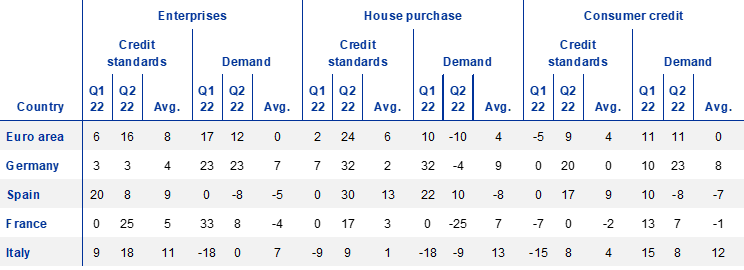
Notes: The “Avg.” columns contain historical averages, which are calculated over the period since the beginning of the survey, excluding the most recent round. Owing to the different sample sizes across countries, which broadly reflect the differences in the national shares in lending to the euro area non-financial private sector, the size and volatility of the net percentages cannot be directly compared across countries.
The July 2022 BLS also included a number of ad hoc questions. Euro area banks reported that their access to money markets, securitisation and particularly debt securities deteriorated, in net terms, in the second quarter of 2022, reflecting the tightening of financial market conditions for banks in the context of the ongoing monetary policy normalisation. By contrast, access to retail funding improved slightly in the second quarter of 2022. In the third quarter of 2022, banks expect a slight deterioration in access to retail funding, and a continued deterioration in access to market-based funding, in particular debt securities funding.
In the first half of 2022, euro area banks’ NPL ratios had a small net tightening impact on credit standards for loans to enterprises, and a neutral impact on credit standards for loans for house purchase and consumer credit and other lending. Over the next six months, euro area banks expect NPL ratios to have a continued tightening impact on credit standards for loans to enterprises, a slight tightening impact on credit standards for consumer credit and other lending, and a broadly neutral impact on credit standards for loans for house purchase. Increased perceptions of risk, costs related to banks’ capital position, access to market financing and pressure related to supervisory or regulatory requirements contributed to a small net tightening impact of NPL ratios on lending conditions in the first half of 2022. At the same time, banks’ risk tolerance and liquidity positions had a neutral impact on lending conditions through banks’ NPLs, while costs related to balance sheet clean-up operations had a slight easing impact.
In the first half of 2022, euro area banks indicated a more pronounced net tightening of credit standards for new loans to enterprises across most of the main economic sectors. These developments are broadly in line with the moderate net tightening of credit standards for loans to firms in the first quarter of 2022 and the more pronounced net tightening in the second quarter of 2022. Over the next six months, euro area banks expect a continued net tightening across all main economic sectors. Banks reported a net increase in demand for loans or credit lines across all main economic sectors, in line with the reported overall increase in demand for loans to firms in the first and second quarters of 2022. Over the next six months, euro area banks expect a strong decline in net demand in the real estate sector, and a small to moderate increase in services, wholesale and retail trade and manufacturing sectors.
Box 1
General notes
The bank lending survey (BLS) is addressed to senior loan officers at a representative sample of euro area banks. In the current round, 153 banks were surveyed, representing all euro area countries and reflecting the characteristics of their respective national banking structures. The main purpose of the BLS is to enhance the Eurosystem’s knowledge of bank lending conditions in the euro area.[2]
BLS questionnaire
The BLS questionnaire contains 22 standard questions on past and expected future developments: 18 backward-looking questions and four forward-looking questions. In addition, it contains one open-ended question. Those questions focus on developments in loans to euro area residents (i.e. domestic and euro area cross-border loans) and distinguish between three loan categories: loans or credit lines to enterprises; loans to households for house purchase; and consumer credit and other lending to households. For all three categories, questions are asked about the credit standards applied to the approval of loans, the terms and conditions of new loans, loan demand, the factors affecting loan supply and demand conditions, and the percentage of loan applications that are rejected. Survey questions are generally phrased in terms of changes over the past three months or expected changes over the next three months. Survey participants are asked to indicate in a qualitative way the strength of any tightening or easing or the strength of any decrease or increase, reporting changes using the following five-point scale: (1) tightened/decreased considerably, (2) tightened/decreased somewhat, (3) basically no change, (4) eased/increased somewhat or (5) eased/increased considerably.
In addition to the standard questions, the BLS questionnaire may contain ad hoc questions on specific topics of interest. Whereas the standard questions cover a three-month time period, the ad hoc questions tend to refer to changes over a longer time period (e.g. over the past and next six months).
Aggregation of banks’ replies to national and euro area BLS results
The responses of the individual banks participating in the BLS are aggregated in two steps to form the euro area results. In the first step, the responses of individual banks are aggregated to national results for the euro area countries. In the second step, the national BLS results are aggregated to euro area BLS results.
In the first step, banks’ replies are aggregated to national BLS results for all countries by applying equal weights to all banks in the sample.[3] For two countries (Malta and Slovakia), national results are additionally aggregated by applying a weighting scheme based on the amounts outstanding of loans to non-financial corporations and households of the individual banks in the respective national samples.
In the second step, since the numbers of banks in the national samples differ considerably and do not always reflect those countries’ respective shares of lending to euro area non-financial corporations and households, the unweighted national survey results of all countries are aggregated to euro area BLS results by applying a weighting scheme based on the national shares of outstanding loans to euro area non-financial corporations and households.
BLS indicators
Responses to questions relating to credit standards are analysed in this report by looking at the difference (the “net percentage”) between the percentage of banks reporting that credit standards applied in the approval of loans have been tightened and the percentage of banks reporting that they have been eased. For all questions, the net percentage is determined on the basis of all participating banks that have business in or exposure to the respective loan categories (i.e. they are all included in the denominator when calculating the net percentage). This means that banks that specialise in certain loan categories (e.g. banks that only grant loans to enterprises) are only included in the aggregation for those categories. All other participating banks are included in the aggregation of all questions, even if a bank replies that a question is “not applicable” (“NA”). This harmonised aggregation method was introduced by the Eurosystem in the April 2018 BLS. It has been applied to all euro area and national BLS results in the current BLS questionnaire, including backdata.[4] The resulting revisions for the standard BLS questions have generally been small, but revisions for some ad hoc questions have been larger owing to a higher number of “not applicable” replies by banks.
A positive net percentage indicates that a larger proportion of banks have tightened credit standards (“net tightening”), whereas a negative net percentage indicates that a larger proportion of banks have eased credit standards (“net easing”).
Likewise, the term “net demand” refers to the difference between the percentage of banks reporting an increase in loan demand (i.e. an increase in bank loan financing needs) and the percentage of banks reporting a decline. Net demand will therefore be positive if a larger proportion of banks have reported an increase in loan demand, whereas negative net demand indicates that a larger proportion of banks have reported a decline in loan demand.
In the assessment of survey balances for the euro area, net percentages between -1 and +1 are generally referred to as “broadly unchanged”. For country results, net percentage changes are reported in a factual manner, as differing sample sizes across countries mean that the answers of individual banks have differing impacts on the magnitude of net percentage changes.
In addition to the “net percentage” indicator, the ECB also publishes an alternative measure of banks’ responses to questions relating to changes in credit standards and net demand. This measure is the weighted difference (“diffusion index”) between the percentage of banks reporting that credit standards have been tightened and the percentage of banks reporting that they have been eased. Likewise, as regards demand for loans, the diffusion index refers to the weighted difference between the percentage of banks reporting an increase in loan demand and the percentage of banks reporting a decline. The diffusion index is constructed in the following way: lenders who have answered “considerably” are given a weight (score of 1) which is twice as large as that given to lenders who have answered “somewhat” (score of 0.5). The interpretation of the diffusion indices follows the same logic as the interpretation of net percentages.
Detailed tables and charts based on the responses provided can be found in Annex 1 for the standard questions and Annex 2 for the ad hoc questions. In addition, BLS time series data are available on the ECB’s website via the Statistical Data Warehouse.
A copy of the questionnaire, a glossary of BLS terms and a BLS user guide with information on the BLS series keys can all be found on the ECB's website.
2 Developments in credit standards, terms and conditions, and net demand for loans in the euro area
2.1 Loans to enterprises
2.1.1 Credit standards for loans to enterprises tightened
Euro area banks tightened their credit standards (i.e. banks’ internal guidelines or loan approval criteria) considerably further for loans or credit lines to enterprises in the second quarter of 2022, i.e. the percentage share of banks reporting a tightening of credit standards was considerably larger than the share of banks reporting an easing (net percentage of banks of 16%, after 6% in the first quarter of 2022; see Chart 1 and Overview table). Credit standards remained somewhat below banks’ expectations in the previous quarter; nevertheless, the extent of net tightening was similar to levels recorded during the early stages of the coronavirus (COVID-19) pandemic and was above historical averages. In the second quarter of 2022, credit standards tightened more strongly for loans to large firms (16%, after 7%), compared with loans to small and medium-sized enterprises (SMEs; 10%, after 7%; see Chart 2) and more strongly for long-term loans (16%, after 6%) than for short-term loans (9%, after 5%).
Banks indicated a considerable further net tightening impact related to the economic outlook and industry or firm-specific situation in the second quarter of 2022 (see Chart 1 and Table 1). In addition to risk perceptions, banks’ risk tolerance declined strongly, contributing to a tightening impact on credit standards in the current environment of high uncertainty. As monetary policy is becoming less accommodative, banks reported that their cost of funds and balance sheet constraints had a small tightening impact on credit standards for loans to euro area firms. This reflects a moderate tightening impact related to capital costs, a small tightening effect from market financing and a broadly neutral effect from banks’ liquidity situation. Competition had a small net tightening impact on credit standards for loans to firms, mainly related to competition from market financing. Banks indicated higher risk perceptions related to the economic outlook as well as the creditworthiness of borrowers and decreased risk tolerance as the main factors explaining the development in credit standards across firm sizes (see Chart 2). While cost of funds and balance sheet constraints had a rather small impact on credit standards for loans to SMEs, the tightening impact was moderate for large firms, related to a moderate tightening impact from capital costs.
Chart 1
Changes in credit standards applied to the approval of loans or credit lines to enterprises, and contributing factors
(net percentages of banks reporting a tightening of credit standards and contributing factors)
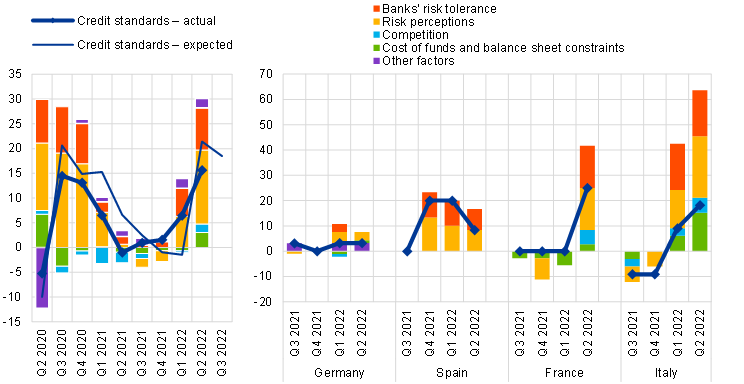
Notes: “Actual” values are changes that have occurred, while “expected” values are changes anticipated by banks. Net percentages are defined as the difference between the sum of the percentages of banks responding “tightened considerably” and “tightened somewhat” and the sum of the percentages of banks responding “eased somewhat” and “eased considerably”. The net percentages for responses to questions related to contributing factors are defined as the difference between the percentage of banks reporting that the given factor contributed to a tightening and the percentage reporting that it contributed to an easing. “Cost of funds and balance sheet constraints” is the unweighted average of “bank’s capital and the costs related to bank’s capital position”, “access to market financing” and “liquidity position”; “risk perceptions” is the unweighted average of “general economic situation and outlook”, “industry or firm-specific situation and outlook/borrower’s creditworthiness” and “risk related to the collateral demanded”; “competition” is the unweighted average of “competition from other banks”, “competition from non-banks” and “competition from market financing”. The net percentages for “other factors” refer to further factors which were mentioned by banks as having contributed to changes in credit standards.
Chart 2
Changes in credit standards applied to the approval of loans or credit lines to SMEs and large enterprises, and contributing factors
(net percentages of banks reporting a tightening of credit standards and contributing factors)
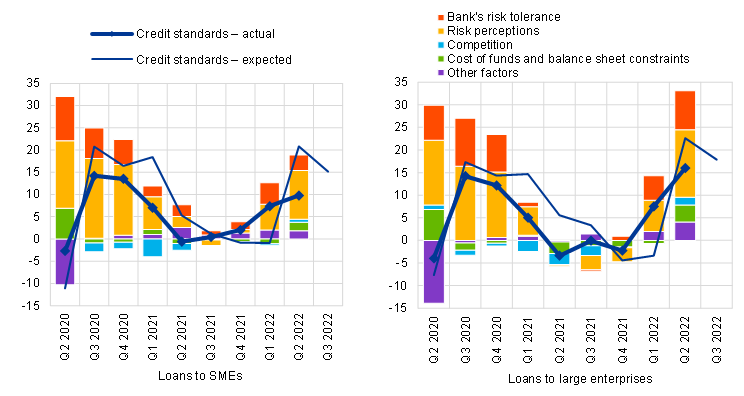
Note: See the notes on Chart 1.
Credit standards for loans to enterprises tightened across all four largest euro area countries in the second quarter of 2022. Higher perceived risks and banks’ lower risk tolerance were the main driving factors in Spain, France and Italy. In addition, banks in Italy and France referred to an overall tightening impact from competition, which is related to lower competition from market financing, while French banks also referred to competition from non-banks as financial market conditions become less favourable. A tightening impact of cost of funds and balance sheet constraints was reported by banks in Italy, driven by higher capital costs, by banks’ ability to access market financing and, to a smaller extent, by their liquidity position.
In the third quarter of 2022, euro area banks expect a net tightening of similar magnitudes to those in the second quarter for credit standards on loans to firms (net percentage of 18%), both for loans to SMEs (net percentage of 15%) and large enterprises (net percentage of 18%).
Table 1
Factors contributing to changes in credit standards for loans or credit lines to enterprises
(net percentages of banks)

Note: See the notes on Chart 1.
2.1.2 Terms and conditions on loans to enterprises tightened
Banks’ overall terms and conditions (i.e. banks’ actual terms and conditions agreed in the loan contract) for new loans to enterprises tightened in the second quarter of 2022 (net percentage of 12%, after 3%; see Chart 3 and Table 2). This was mainly on account of a considerable widening of margins on riskier loans (net percentage of 16%; margins defined as the spread over relevant market reference rates), while the widening of margins on average loans (net percentage of 6%) and collateral requirements (net percentage of 5%) had a more moderate contribution. Tighter terms and conditions are confirmed by data on the actual aggregate cost of borrowing for firms, showing an increase in rates for May 2022, the latest available month. Banks also reported that changes in maturity, covenants and non-interest rate charges contributed to the net tightening of overall terms and conditions for loans to firms. Developments in overall terms and conditions were similar for loans to SMEs and large firms, with the widening of margins on riskier loans being considerable across both firm categories, whereas the widening of margins on average loans had broadly no impact for SMEs, and a moderate impact for large firms (see Chart 4). Other terms and conditions related to changes in collateral, covenants and maturity had a moderate impact on the terms and conditions for loans to large firms and SMEs.
Chart 3
Changes in terms and conditions on loans or credit lines to enterprises
(net percentages of banks reporting a tightening of terms and conditions)
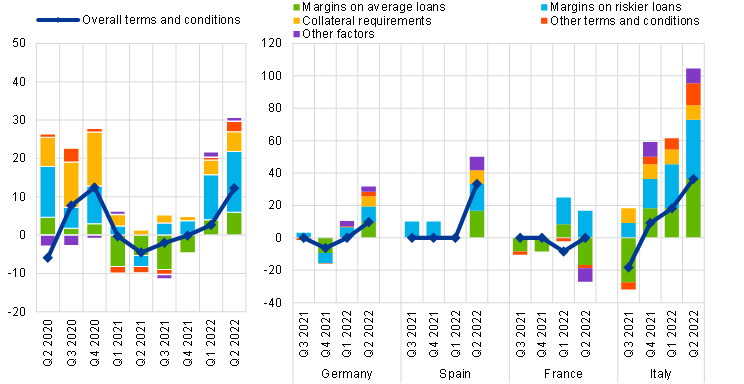
Notes: “Margins” are defined as the spread over a relevant market reference rate. “Other terms and conditions” is the unweighted average of “non-interest rate charges”, “size of the loan or credit line”, “loan covenants” and “maturity”. The net percentages for “other factors” refer to further factors which were mentioned by banks as having contributed to changes in terms and conditions.
Chart 4
Changes in terms and conditions on loans or credit lines to SMEs and large enterprises
(net percentages of banks reporting a tightening of terms and conditions)
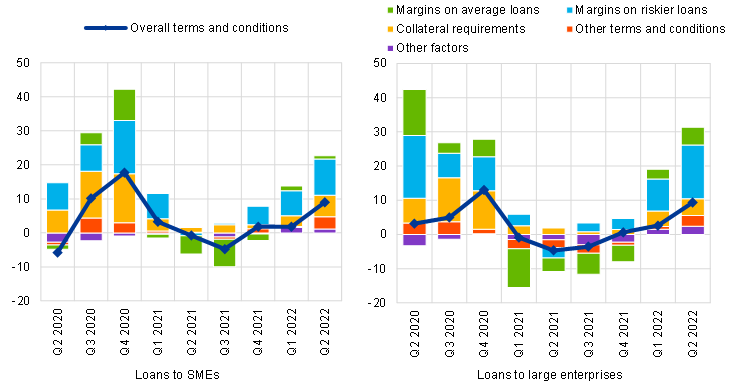
Note: See the notes on Chart 3.
Banks’ higher risk perceptions, cost of funds and decreased risk tolerance were the main drivers of the net tightening of overall terms and conditions for loans to firms in the second quarter of 2022 (see Table 3). In the current environment of high uncertainty, risk perceptions related to the economic outlook and the creditworthiness of firms had a large tightening impact on terms and conditions, whereas the impact of the collateral demanded was more moderate. As monetary policy is becoming less accommodative, banks indicated that costs related to both capital and market financing had a tightening impact on credit standards, while competition related to market financing also had a moderate tightening impact for overall terms and conditions.
Table 2
Changes in terms and conditions on loans or credit lines to enterprises
(net percentages of banks)

Note: See the notes on Chart 3.
Table 3
Factors contributing to changes in overall terms and conditions on loans or credit lines to enterprises
(net percentages of banks)

Notes: The net percentages for these questions relating to contributing factors are defined as the difference between the percentage of banks reporting that the given factor contributed to a tightening and the percentage reporting that it contributed to an easing. See the notes on Chart 1.
In the largest euro area countries, overall terms and conditions on loans or credit lines to enterprises tightened, on balance, in Germany, Spain and Italy, and remained unchanged in France in the second quarter of 2022. Across the four largest economies, banks mentioned higher risk perceptions as the main factor which contributed to tightening, while banks’ decreased risk tolerance had a tightening impact for overall terms and conditions in Germany, Spain and Italy. In addition, capital costs contributed to a tightening in Germany and Italy, while increased market financing costs contributed to a tightening of credit conditions across all four largest euro area countries. Banks in Germany and Italy also reported a tightening impact of their liquidity position on overall terms and conditions. Margins on both average and riskier loans to firms widened in Germany, Spain and Italy, while in France margins widened for riskier loans and narrowed for average loans.
2.1.3 Rejection rate for loans to enterprises was broadly unchanged
In the second quarter of 2022, euro area banks reported broadly no change in the share of rejected applications for loans to firms (net percentage of 1%, after 4% in the previous quarter). This development may suggest that tightening credit standards have, on balance, not yet translated to more rejections for new loans to firms. The net increase in the share of rejected loan applications was similarly small for loans to SMEs (net percentage of 3%) and for loans to large firms (net percentage of 2%).
Across the largest euro area countries, banks reported that in net terms the share of rejected applications increased in Spain and Germany, was unchanged in France and decreased in Italy. Developments were similar across firm sizes for Spain and France, while the net increase in the share of rejected applications was higher for large firms in Germany, related to the more pronounced tightening of lending standards for large firms in comparison with SMEs. The net decrease in the rejection rate in Italy was entirely driven by the net decrease for loans to large firms.
2.1.4 Net demand for loans to enterprises continued to increase
According to euro area banks, firms’ net demand for loans continued to increase in the second quarter of 2022, in line with the expectations in the previous quarter (net percentage of 12%, after 17% in the first quarter of 2022; see Chart 5 and Overview table). Loan demand increased strongly in net terms for short-term maturities (net percentage of 23%), reflecting firms’ increased need to cover higher production costs and working capital. At the same time, net demand for long-term loans was broadly unchanged (net percentage of 1%) in the second quarter of 2022. While the available monetary data show an increase in long-term loan flows for April and May, leading indicator properties of BLS loan demand for net loan growth to firms would suggest a potential weakening in long-term loan growth in the coming months.[5] In addition, BLS banks indicated that loan demand increased in net terms for SMEs (net percentage of 9%, see Chart 6) and for large firms (net percentage of 14%).
Chart 5
Changes in demand for loans or credit lines to enterprises, and contributing factors
(net percentages of banks reporting an increase in demand, and contributing factors)
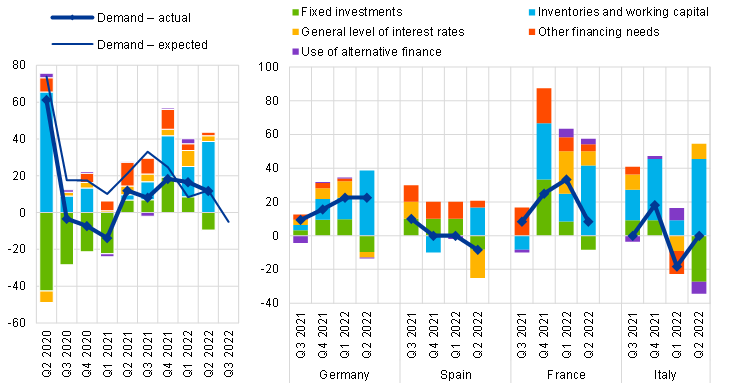
Notes: “Actual” values are changes that have occurred, while “expected” values are changes anticipated by banks. Net percentages for the questions on demand for loans are defined as the difference between the sum of the percentages of banks responding “increased considerably” and “increased somewhat” and the sum of the percentages of banks responding “decreased somewhat” and “decreased considerably”. The net percentages for responses to questions relating to contributing factors are defined as the difference between the percentage of banks reporting that the given factor contributed to increasing demand and the percentage reporting that it contributed to decreasing demand. “Other financing needs” is the unweighted average of “mergers/acquisitions and corporate restructuring” and “debt refinancing/restructuring and renegotiation”; “use of alternative finance” is the unweighted average of “internal financing”, “loans from other banks”, “loans from non-banks”, “issuance/redemption of debt securities” and “issuance/redemption of equity”.
Chart 6
Changes in demand for loans or credit lines to SMEs and large enterprises, and contributing factors
(net percentages of banks reporting an increase in demand, and contributing factors)
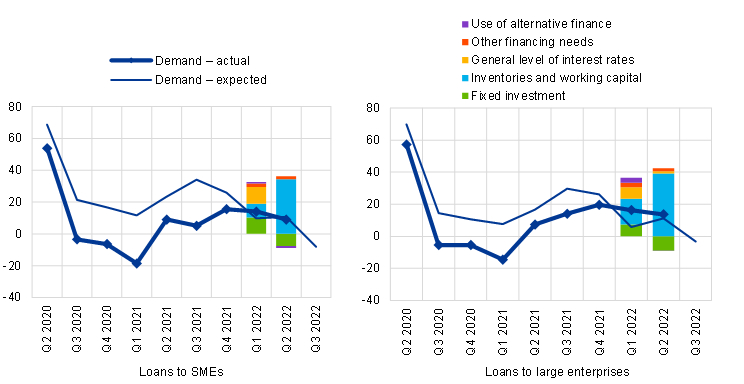
Notes: See the notes on Chart 5. Developments across firm sizes in the factors having an impact on loan demand were added in the April 2022 survey round.
Loan demand continued to be driven by firms’ financing needs for working capital, which is likely related to increased energy and raw material prices and continuing supply chain disruptions (see Chart 5 and Table 4). For the first time since the first quarter of 2021, fixed investment had a dampening impact on firms’ net demand for loans, as they may be postponing investment in the current uncertain environment. In line with subdued growth, sentiment indicators such as the PMI already signal a contraction in manufacturing activity for the end of the second quarter. In addition, the positive contribution of the general level of interest rates to loan demand was more moderate (net percentage of 3%) compared with the previous quarter. Loan demand was also supported, on balance, by other financing needs related to debt restructuring. While banks indicated tightening credit conditions for loans to corporates, firms might still have incentives to frontload their demand for loans or renegotiate loan amounts or maturities against the background of expected further monetary policy normalisation. Loan demand was also supported, on balance, by other financing needs related to debt securities issuance pointing to substitution effects away from market-based financing in the context of market rates increasing more strongly than lending rates. Across firm sizes, banks reported that the increase in loan demand for inventories and working capital was more pronounced for large firms than for SMEs in the second quarter of 2022, which is in line with larger firms being more exposed to international markets and therefore to the current supply chain disruptions (see Chart 6). The dampening impact of fixed investment on loan demand was similar across firm sizes. In addition, other financing needs related to debt restructuring had a moderate positive impact on loan demand for large firms, whereas mergers and acquisitions had a positive impact for SMEs. The general level of interest rates had a broadly neutral impact on loan demand across firm sizes.
Table 4
Factors contributing to changes in demand for loans or credit lines to enterprises
(net percentages of banks)

Note: See the notes on Chart 5.
In the largest euro area countries, banks reported a net increase in demand for loans to firms in Germany and France, while loan demand remained unchanged according to banks in Italy and decreased in Spain in the second quarter of 2022. Across all four largest euro area countries, financing needs for inventories and working capital had a strong positive impact on loan demand, while fixed investment had a moderate to strong negative impact. For firms in France and Italy, banks indicated a moderate positive impact from the general level of interest rates, possibly related to frontloading effects, whereas this factor had a negative impact for firms in Germany and Spain. In terms of other financing needs, debt restructuring had a positive impact on loan demand in all countries except Italy, while mergers and acquisitions had a negative impact in Germany and France. Debt securities issuance as a source of alternative finance had a positive impact on demand in Spain, France and Italy. However, the overall impact of alternative financing on loan demand was negative in Italy, due to the large negative impact of loans from other banks and non-banks.
In the third quarter of 2022, banks expect a net decline in demand for loans to firms (net percentage of -5%), for both SMEs (net percentage of -8%) and large firms (net percentage of -3%). Demand for long-term loans is expected to decrease considerably (net percentage of -14%), while the demand for short-term loans is expected to remain positive (net percentage of 12%), albeit less strong than in the second quarter.
2.2 Loans to households for house purchase
2.2.1 Credit standards for loans to households for house purchase tightened strongly
In the second quarter of 2022, euro area banks reported a strong net tightening of credit standards for loans to households for house purchase (net percentage of banks at 24%, after 2% in the first quarter of 2022; see Chart 7 and Overview table), above expectations reported in the previous survey round, and markedly above the historical average for credit standards (6%).
Chart 7
Changes in credit standards applied to the approval of loans to households for house purchase, and contributing factors
(net percentages of banks reporting a tightening of credit standards, and contributing factors)
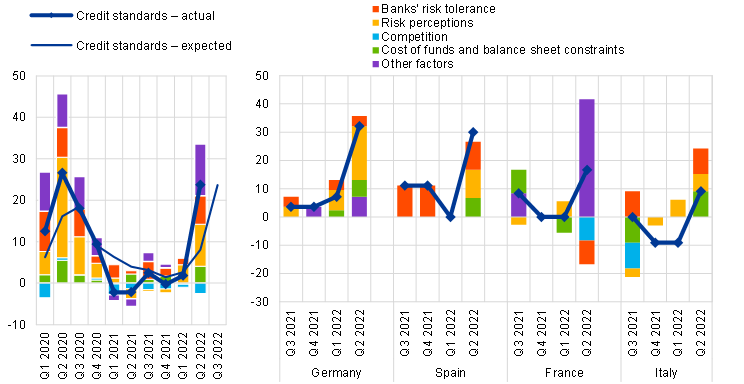
Notes: See the notes on Chart 1. “Cost of funds and balance sheet constraints” is the unweighted average of “bank’s capital and the costs related to bank’s capital position”, “access to market financing” and “liquidity position”; “Risk perceptions” is the unweighted average of “general economic situation and outlook”, “housing market prospects, including expected house price developments” and “borrower’s creditworthiness”; “competition” is the unweighted average of “competition from other banks” and “competition from non-banks”. The net percentages for “other factors” refer to further factors which were mentioned by banks as having contributed to changes in credit standards, currently mainly related to macroprudential policy recommendations.
Perceptions of increased risk and country-specific other factors contributed to the net tightening, alongside a moderate impact from banks’ lower risk tolerance, and banks’ cost of funds and balance sheet constraints (see Chart 7 and Table 5). Banks reported a more pronounced contribution from increased perceptions of risk than in the previous quarter, stemming from views on the general economic outlook, borrower creditworthiness and housing market prospects. This marks the second consecutive quarter of risk perceptions having a tightening impact, which excluding the pandemic period, had not been recorded since 2014. Coupled with a fall in demand (Section 2.2.4), this may indicate a possible turning point in housing market lending conditions. Country-specific other factors also contributed considerably to the net tightening, especially in France. In addition, there was a moderate positive impact from banks’ cost of funds and balance sheet constraints, particularly from costs related to banks’ capital positions. At the same time, pressure from competition from other banks was the only factor that had an easing impact.
Across all four largest euro area countries, credit standards tightened in net terms. Some banks in France noted that, while competition from banks and a higher risk tolerance had a net easing effect, regulations set by the French High Council for Financial Stability and the usury rate (a maximum interest rate on loans) contributed towards a tightening impact. In Germany, Italy and Spain, the cost of funds and balance sheet constraints, a higher level of risk perceptions, and lower risk tolerance contributed towards a tightening, with a neutral impact from competition.
In the third quarter of 2022, euro area banks expect a continued pronounced net tightening of credit standards on loans to households for house purchase (net percentage of banks of 24%).
Table 5
Factors contributing to changes in credit standards for loans to households for house purchase
(net percentages of banks)

Note: See the notes on Chart 7.
2.2.2 Terms and conditions on loans to households for house purchase tightened strongly
Banks reported a strong net tightening of overall terms and conditions for housing loans in the second quarter of 2022 (net percentage of banks of 22%, after 6% in the previous quarter; see Chart 8 and Table 6). This reflects increases in the level of interest rates (recorded under “other factors” in Chart 8), in line with increases in euro area mortgage interest rates observed since the beginning of 2022. At the same time, there was a net narrowing of banks’ margins on average loans and a slight net narrowing of margins on riskier loans. This was due to relevant market reference rates rising faster than interest rates charged on housing loans, leading to a contraction in loan margins. In addition, a slight net tightening of loan-to-value (LTV) ratios, other loan size limits (part of “other terms and conditions” in Chart 8) and collateral requirements was reported.
Chart 8
Changes in terms and conditions on loans to households for house purchase
(net percentages of banks reporting a tightening of terms and conditions)

Notes: “Margins” are defined as the spread over a relevant market reference rate. “Other terms and conditions” is the unweighted average of “loan-to-value ratio”, “other loan size limits”, “non-interest rate charges” and “maturity”. The net percentages for “other factors” refer to further factors which were mentioned by banks as having contributed to changes in terms and conditions.
Table 6
Changes in terms and conditions on loans to households for house purchase
(net percentages of banks)

Note: See the notes on Chart 8.
Perceived risks and banks’ cost of funds and balance sheet constraints, in line with the reported impact of higher market interest rates in the context of monetary policy normalisation, contributed to a net tightening of overall terms and conditions (see Table 7). In addition, banks’ lower risk tolerance contributed towards a tightening of terms and conditions and had a widening impact on margins. On the other hand, pressure from competition had a broadly neutral impact on overall terms and conditions.
In all four largest euro area countries, overall terms and conditions for housing loans tightened in net terms. It should be noted, however, that loan margins narrowed markedly in France on both average and riskier loans, because the interest rate on loans had not risen as quickly as market reference rates. Margins widened for both riskier and average loans in Germany and Spain. Additionally, Italian and German banks noted a tightening of LTV ratios, while German banks also recorded a tightening of other loan size limits, and Italian banks reported tighter maturity limits. In all countries, banks’ cost of funds and balance sheet conditions contributed towards a tightening of terms and conditions. German, Spanish and Italian banks reported that increased perceptions of risk and lower risk tolerance contributed towards a tightening, but French banks noted a neutral impact from these factors. Competition had a tightening effect in Germany and Italy, an easing effect in Spain, and a neutral impact in France.
Table 7
Factors contributing to changes in overall terms and conditions on loans to households for house purchase
(net percentages of banks)

Note: The net percentages for these questions relating to contributing factors are defined as the difference between the percentage of banks reporting that the given factor contributed to a tightening and the percentage reporting that it contributed to an easing.
2.2.3 Rejection rate for housing loans increased strongly
In the second quarter of 2022, euro area banks reported, on balance, a strong increase in the share of rejected formal and informal applications for housing loans (28%, after 1% in the previous quarter). This was the largest net increase since the series began in the first quarter of 2015, reflecting the current environment of uncertainty surrounding lending, and the tightening of credit standards.
Across the four largest euro area countries, the share of loans that were rejected increased in Germany, Spain and France, while it was unchanged in Italy.
2.2.4 Net demand for housing loans decreased
Banks reported a decrease in net demand for housing loans in the second quarter of 2022 (net percentage of banks of -10%, after 10% in the first quarter of 2022; see Chart 9 and Overview table), in line with previous expectations.
Chart 9
Changes in demand for loans to households for house purchase, and contributing factors
(net percentages of banks reporting an increase in demand, and contributing factors)
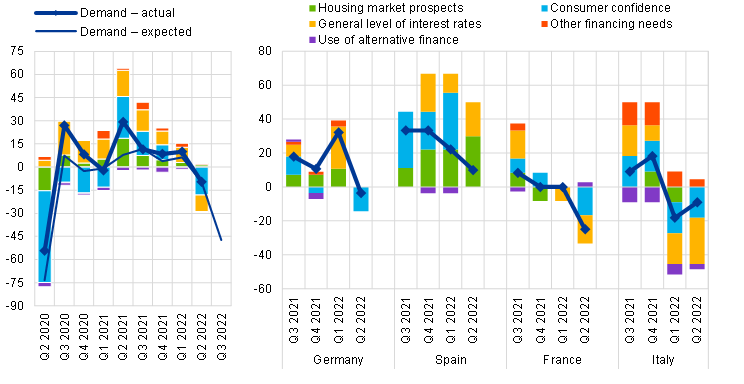
Notes: See the notes on Chart 5. “Other financing needs” is the unweighted average of “debt refinancing/restructuring and renegotiation” and “regulatory and fiscal regime of housing markets”; “use of alternative finance” is the unweighted average of “internal finance of house purchase out of savings/down payment”, “loans from other banks” and “other sources of external finance”.
Declining consumer confidence and the current interest rate environment both contributed negatively towards loan demand (see Chart 9 and Table 8). The negative contribution of consumer confidence reflects the latest figures from the European Commission’s consumer confidence indicator, which in June 2022 fell to its lowest level since the early stages of the pandemic. The negative net impact of the level of interest rates on loan demand marks a reversal compared with previous quarters and indicates that the recent considerable increases in interest rates on loans for house purchase may be starting to have a downward impact on demand. While actual mortgage lending volumes remained strong in May, the reported decrease in demand alongside tightening terms and conditions and credit standards may be an early signal of a turning point in euro area lending for house purchase. Housing market prospects had a broadly neutral impact on overall demand, after a declining positive impact in the previous quarter. Excluding the early pandemic period, this was the first time since 2013 that housing market prospects had not contributed positively to housing loan demand. In addition, other financing needs and the use of alternative finance also had a broadly neutral impact.
Across the largest euro area countries, banks in Germany, France and Italy recorded a net decrease in demand for housing loans, while banks in Spain reported a net increase in the second quarter of 2022. In Germany, lower consumer confidence drove the net decline, while in France and Italy banks reported that both consumer confidence and the general level of interest rates had a negative impact. Spanish banks attributed the reported increase to housing market conditions and the current interest rate environment, possibly related to frontloading effects.
In the third quarter of 2022, banks expect a strong net decline in the demand for housing loans (net percentage of banks of -47%). It would be the largest decline since the second quarter of 2020 and, if the pandemic period is excluded, the largest since the fourth quarter of 2008.
Table 8
Factors contributing to changes in demand for loans to households for house purchase
(net percentages of banks)

Note: See the notes on Chart 9.
2.3 Consumer credit and other lending to households
2.3.1 Credit standards for consumer credit and other lending to households tightened moderately
Banks reported a moderate net tightening of credit standards on consumer credit and other lending to households in the second quarter of 2022 (net percentage of 9%; see Chart 10 and Overview table). This was the first net tightening since the first quarter of 2021.
Banks’ increased risk perceptions mainly contributed to the net tightening of credit standards (see Chart 10 and Table 9). This was mostly related to perceptions regarding the economic outlook and the creditworthiness of consumers and to a small extent to the risks related to the collateral demanded. Banks’ cost of funds and balance sheet conditions had a slight tightening effect.
Across the largest euro area countries, credit standards for consumer credit and other lending to households tightened in net terms in Germany, Spain and Italy, and were unchanged on balance in France. Increased risk perceptions contributed towards the net tightening in Germany, Spain and Italy, while Spanish and Italian banks also reported that lower risk tolerance had a net tightening impact. In addition, banks in Italy noted that their cost of funds and balance sheet constraints contributed towards a tightening. While credit standards were unchanged on balance in France, banks reported an easing contribution from higher risk tolerance.
In the third quarter of 2022, euro area banks expect a continued net tightening of credit standards for consumer credit and other lending to households (net percentage of 13%).
Chart 10
Changes in credit standards applied to the approval of consumer credit and other lending to households, and contributing factors
(net percentages of banks reporting a tightening of credit standards, and contributing factors)
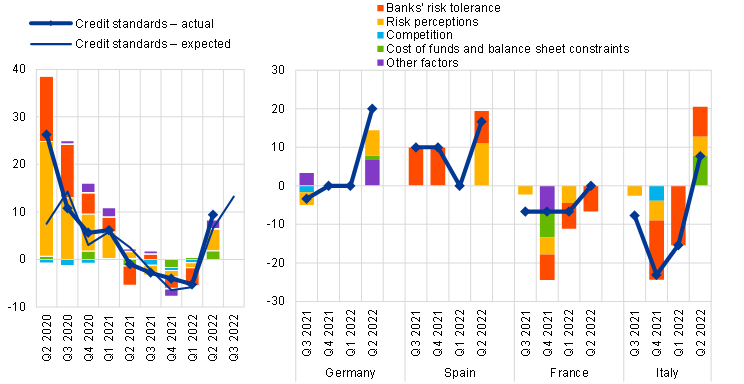
Notes: See the notes on Chart 1. “Cost of funds and balance sheet constraints” is the unweighted average of “bank’s capital and the costs related to bank’s capital position”, “access to market financing” and “liquidity position”; “Risk perceptions” is the unweighted average of “general economic situation and outlook”, “creditworthiness of consumers” and “risk on the collateral demanded”; “competition” is the unweighted average of “competition from other banks” and “competition from non-banks”. The net percentages for “other factors” refer to further factors which were mentioned by banks as having contributed to changes in credit standards.
Table 9
Factors contributing to changes in credit standards for consumer credit and other lending to households
(net percentages of banks)

Note: See the notes on Chart 10.
2.3.2 Terms and conditions on consumer credit and other lending to households tightened
In the second quarter of 2022, banks’ overall terms and conditions applied when granting consumer credit and other lending to households tightened in net terms (net percentage of 11%, after -2% in the previous quarter; see Chart 11 and Table 10). While interest rates increased, (part of “other factors” in Chart 11), it should be noted that there was a considerable net narrowing of margins on average loans (net percentage of -17%) and a net narrowing of margins on riskier loans (-10%), as market reference rates increased faster than interest rates on consumer credit.
Chart 11
Changes in terms and conditions on consumer credit and other lending to households
(net percentages of banks reporting a tightening of terms and conditions)
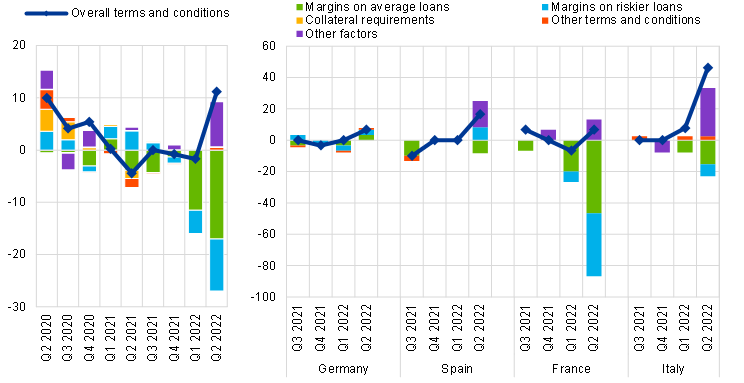
Notes: “Margins” are defined as the spread over a relevant market reference rate. “Other terms and conditions” is the unweighted average of “size of the loan”, “non-interest rate charges” and “maturity”. The net percentages for “other factors” refer to further factors which were mentioned by banks as having contributed to changes in terms and conditions.
Reflecting this, banks’ cost of funds and balance sheet conditions contributed towards a net tightening of terms and conditions (net percentage of 10%; see Table 11), but also towards a narrowing of margins on average and riskier loans (-16% and -13% respectively). Increased perceptions of risk also had a moderate tightening impact on overall terms and conditions.
Across all four largest euro area countries, overall terms and conditions for consumer credit and other lending to households tightened in net terms. In Germany, this tightening was related to a widening of loan margins and restrictions on the size of loans. Spanish banks also noted a net widening of margins for riskier loans. Despite the headline tightening of terms and conditions, which was related to higher interest rates (part of “other factors”), banks in Spain, Italy and France reported a net narrowing of loan margins on average loans, while French and Italian banks also reported a net narrowing of margins on riskier loans. Banks’ cost of funds and balance sheet conditions had a net tightening impact on overall terms and conditions in Germany, Spain and Italy, but a neutral impact in France. Competition had a tightening impact in France and Italy, a neutral impact in Germany and an easing impact in Spain. French banks reported that higher risk tolerance had an easing impact, while German banks also attributed the tightening of terms and conditions to increased perceptions of risk.
Table 10
Changes in terms and conditions on consumer credit and other lending to households
(net percentages of banks)

Note: See the notes on Chart 11.
Table 11
Factors contributing to changes in overall terms and conditions on consumer credit and other lending to households
(net percentages of banks)

Note: The net percentages for these questions relating to contributing factors are defined as the difference between the percentage of banks reporting that the given factor contributed to a tightening and the percentage reporting that it contributed to an easing.
2.3.3 Rejection rate for consumer credit and other lending to households increased moderately
In the second quarter of 2022, euro area banks reported a moderate net increase in the share of rejected formal and informal applications for consumer credit and other lending to households (5%, after -2% in the previous survey round). This is consistent with the reported moderate net tightening in credit standards for consumer credit and other lending to households in the second quarter of 2022.
Across the largest euro area countries, the rejection rate increased on balance in Germany and Spain, whereas it was unchanged in Italy and France.
2.3.4 Net demand for consumer credit and other lending to households increased
In the second quarter of 2022, banks reported a continued net increase in demand for consumer credit and other lending to households (net percentage of banks at 11%, after 11% in the previous quarter; see Chart 12 and Overview table). This is broadly in line with recently observed increases in the annual growth rate in loans for consumer credit.
Chart 12
Changes in demand for consumer credit and other lending to households, and contributing factors
(net percentages of banks reporting an increase in demand, and contributing factors)
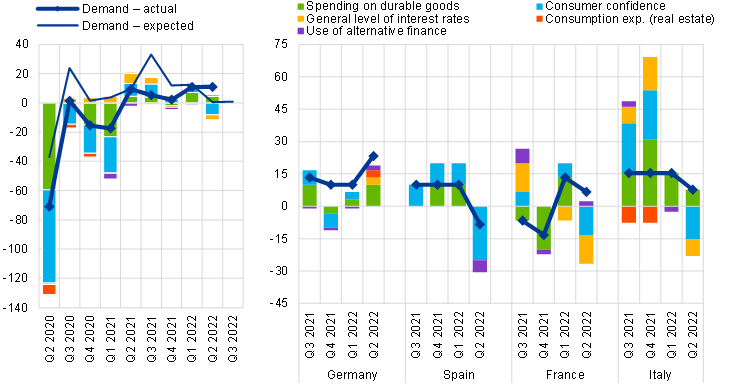
Notes: See the notes on Chart 5. “Use of alternative finance” is the unweighted average of “internal financing out of savings”, “loans from other banks” and “other sources of external finance”. “Consumption exp. (real estate)” denotes “consumption expenditure financed through real estate-guaranteed loans”.
Spending on durable goods made a continued positive contribution to demand for consumer credit (see Chart 12 and Table 12), likely reflecting recent price increases and the reopening of the economy. Conversely, consumer confidence had a negative contribution to demand, after a positive contribution last quarter, reflecting the observed recent decline in the European Commission’s consumer confidence indicator. The general level of interest rates had a dampening effect on demand, reflecting in part the pass-through of higher interest rates to consumers. Use of alternative finance had a broadly neutral impact on demand.
Across the four largest euro area countries, banks in Germany, Italy and France reported a net increase in demand for consumer credit, while banks in Spain reported a net decrease. In Germany, increased spending on durables was the primary driver of the increase in demand, while the general level of interest rates, consumption expenditure financed through real estate-guaranteed loans and a lower use of internal savings also had a slight positive impact. Italian banks reported spending on durables as being the key driver of increased demand, while lower consumer confidence and the general level of interest rates had a dampening effect. For French banks, the increase in demand was attributed to a more limited use of internal savings for financing, while lower consumer confidence and the interest rate environment had a net downward effect. The decline recorded in Spain was attributed to both the use of internal savings as a financing source and declining consumer confidence.
In the third quarter of 2022, banks expect demand for consumer credit and other lending to remain broadly unchanged (net percentage of 1%).
Table 12
Factors contributing to changes in demand for consumer credit and other lending to households
(net percentages of banks)

Note: See the notes on Chart 12.
3 Ad hoc questions
3.1 Banks’ access to retail and wholesale funding
The July 2022 survey included a question on the extent to which the situation in financial markets had affected banks’ access to retail and wholesale funding.
In the second quarter of 2022, banks reported that their access to money markets, securitisation and particularly debt securities deteriorated in net terms, reflecting the tightening of market-based funding conditions for banks. By contrast, access to retail funding improved slightly (net percentage of -2% reported deteriorated access, after -1% in the first quarter of 2022; see Chart 13). Compared with monetary data, household deposit inflows remained robust in May 2022, whereas deposit flows of firms were close to zero in April and May. The impact of elevated inflation on deposits and recent corporate deposit developments may signal a deterioration in access to retail funds, which is partly expected by banks for the third quarter of 2022. Access to debt securities deteriorated markedly in the second quarter of 2022.
Chart 13
Banks’ assessment of funding conditions and the ability to transfer credit risk off the balance sheet
(net percentages of banks reporting a deterioration in market access)
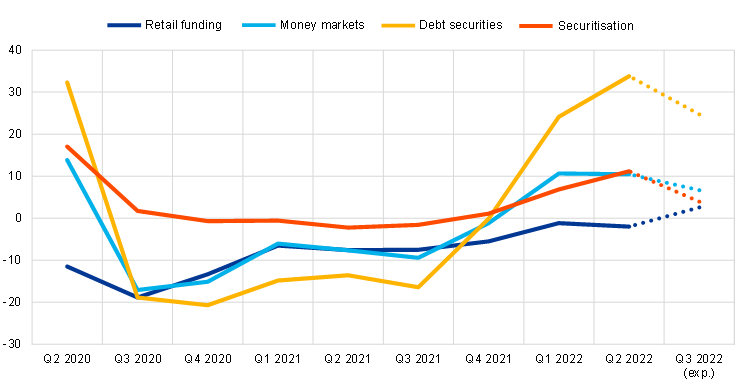
Note: The net percentages are defined as the difference between the sum of the percentages of banks responding “deteriorated considerably” and “deteriorated somewhat” and the sum of the percentages of banks responding “eased somewhat” and “eased considerably”.
Table 13
Banks’ assessment of funding conditions and the ability to transfer credit risk off the balance sheet
(net percentages of banks reporting a deterioration in market access)

Note: See the notes on Chart 13.
In the third quarter of 2022, euro area banks expect, on balance, a continued pronounced deterioration in their access to market funding, reflecting further expectations of monetary policy normalisation. Access to debt securities (net percentage of 25%), securitisation (net percentage of 4%) and money markets (net percentage of 7%) is expected to deteriorate. In addition, banks expect their access to retail funds to deteriorate, driven by an expected deterioration for long-term deposits (net percentage of 5%), while access to short-term deposits is expected to remain unchanged (net percentage of 0%).
3.2 The impact of banks’ NPL ratios on their lending policies
The July 2022 survey questionnaire included a biannual ad hoc question about the impact that banks’ NPL ratios had on their lending policies and the factors through which NPL ratios contributed to changes in lending policies. Banks were asked about the impact on loans to enterprises, loans to households for house purchase, and consumer credit and other lending to households over the past six months and the next six months.
Euro area banks reported a small net tightening impact of their NPL ratios on credit standards for loans to enterprises in the first half of 2022 (net percentage of 2%, after 2% in the first half of 2021, see Chart 14) and a neutral impact for loans to households for house purchase (0% after 0%) and for consumer credit and other lending (0% after 2%). Banks reported that NPL ratios had a slight tightening effect on terms and conditions for loans to firms (2%, after -1%), a neutral impact for housing loans (0%, after -2%), and a small easing impact on conditions for consumer credit (-2%, after 0%) in the first half of 2022 (see Chart 14).
Banks cited increased perceptions of risk, costs related to their capital position, access to market financing, and pressure related to supervisory or regulatory requirements as contributing to a small net tightening impact of NPL ratios on lending conditions in the first half of 2022 (see Chart 15). At the same time, costs related to balance sheet clean-up had a slight easing impact while banks’ risk tolerance and liquidity positions had a neutral impact on lending conditions.
Chart 14
Impact of banks’ NPL ratios on credit standards and terms and conditions
(net percentages of banks)
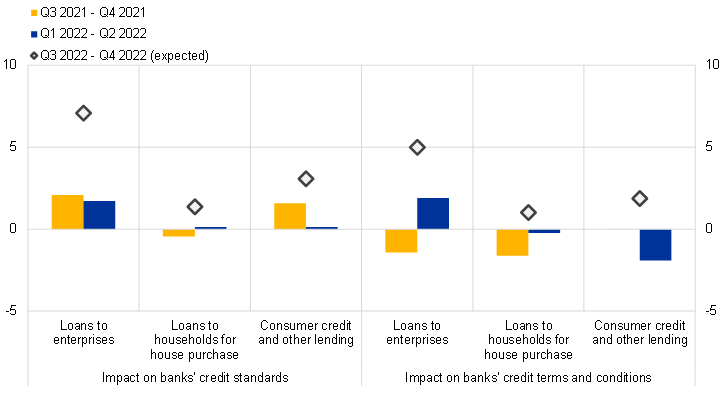
Notes: The NPL ratio is defined as the stock of gross NPLs on a bank’s balance sheet as a percentage of the gross carrying amount of loans. Changes in credit standards and/or terms and conditions can be caused by changes to the NPL ratio or by changes to regulations or the bank’s assessment of the level of the NPL ratio. Net percentages are defined as the difference between the sum of the percentages of banks responding “contributed considerably to tightening” and “contributed somewhat to tightening” and the sum of the percentages of banks responding “contributed somewhat to easing” and “contributed considerably to easing”. The diamonds denote expectations indicated by banks in the current round.
Over the next six months, euro area banks expect NPL ratios to have a tightening impact on both credit standards and terms and conditions for loans to firms, a slight tightening impact on credit standards and terms and conditions for loans for consumer credit, and a broadly neutral impact on credit standards and terms and conditions for loans for house purchase. Pressures related to supervisory or regulatory requirements and costs related to capital positions of banks are expected to have a tightening impact on lending policies via NPL ratios. Access to market financing, increased perceived risks and lower risk tolerance are expected to slightly reinforce this tightening effect. At the same time, the impact of banks’ liquidity positions and costs related to balance sheet clean-up operations are expected to have a neutral impact.
Chart 15
Contributions of factors through which NPL ratios affect banks’ policies on lending to enterprises and households
(net percentages of banks)

Note: See the notes on Chart 14.
3.3 Bank lending conditions and loan demand across main sectors of economic activity
The July 2022 survey questionnaire included a biannual ad hoc question to collect information on changes in banks’ credit standards, overall terms and conditions and loan demand across the main economic sectors over the past and next six months. Banks were asked to provide information covering five sectors: manufacturing, construction (excluding real estate), services (excluding financial services and real estate), wholesale and retail trade, and real estate (including both real estate construction and real estate services).
Euro area banks indicated a more pronounced net tightening in credit standards for new loans to enterprises across most of the main economic sectors in the first half of 2022 (see Chart 16). These developments are broadly in line with the moderate net tightening in credit standards for loans to firms in the first quarter of 2022 and the more pronounced net tightening in the second quarter of 2022. Similar to the second half of 2021, the net tightening of credit standards was most pronounced for firms in the commercial real estate sector (17%, after 10%). In the first half of 2022, credit standards tightened in net terms also in the residential real estate sector (16%, after 2%) construction sector (9%, after 1%), wholesale and retail trade (8%, after 6%) and manufacturing (2%, after -1%), while credit standards were broadly unchanged for loans to firms in the services sector (0%, after -1%). Banks’ overall terms and conditions tightened across all main sectors of economic activity (see Chart 17).
Over the next six months, euro area banks expect a net tightening in credit standards and terms and conditions for loans to firms across all main sectors of economic activity.
Chart 16
Changes in credit standards for new loans to enterprises across main economic sectors
(net percentages of banks; over the past six months and the next six months)
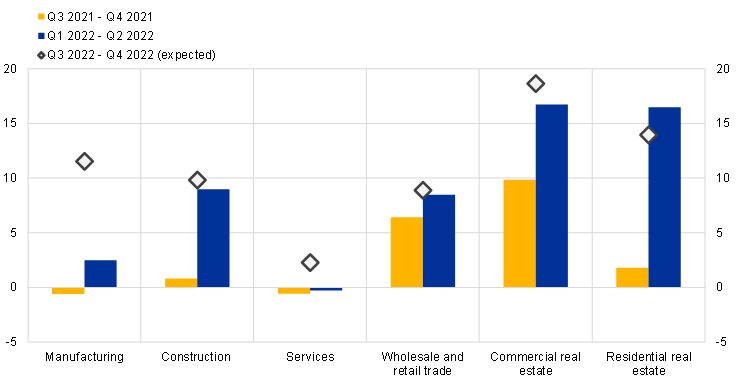
Notes: The net percentages refer to the difference between the sum of the percentages of banks responding “deteriorated considerably” and “deteriorated somewhat” and the sum of the percentages of banks responding “eased somewhat” and “eased considerably". The diamonds denote expectations indicated by banks in the current round.
Banks reported a net increase in demand for loans or credit lines across all main economic sectors, in line with the reported overall increase in demand for loans to firms in the first and second quarters of 2022 (see Chart 18). Demand for loans increased most in net terms in manufacturing, real estate and construction, consistent with overall net demand for loans to enterprises being mostly driven by inventories and working capital needs in both the first and second quarter of 2022, in the context of rising energy, material and construction costs. Continuing supply chain disruptions also explain the increase in net demand in wholesale and retail trade sectors, where firms require more working capital due to larger inventory needs.
Over the next six months, euro area banks expect a strong decline in net demand for loans in the real estate sector and a small to moderate increase in services, wholesale and retail trade and manufacturing sectors. This is mostly in line with the expected moderate decrease in net loan demand from firms for the third quarter of 2022.
Chart 17
Changes in terms and conditions for new loans to enterprises across main economic sectors
(net percentages of banks; over the past six months and the next six months)
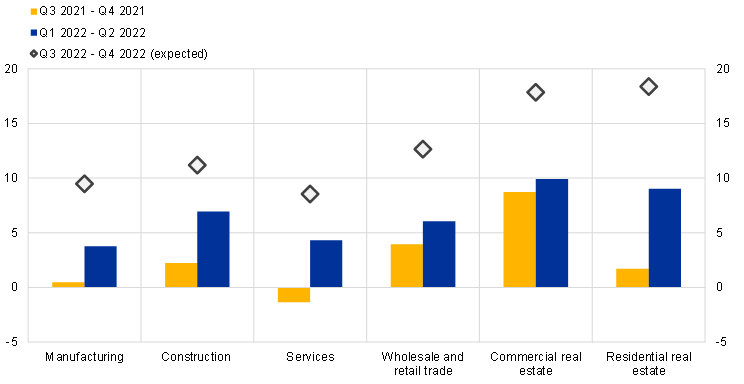
Note: See the notes on Chart 16.
Chart 18
Changes in demand for loans or credit lines to enterprises across main economic sectors
(net percentages of banks)

Notes: The net percentages refer to the difference between the sum of the percentages of banks responding “increased considerably” and “increased somewhat” and the sum of the percentages of banks responding “decreased somewhat” and “decreased considerably". The diamonds denote expectations indicated by banks in the current round.
Annexes
See more.
© European Central Bank, 2022
Postal address 60640 Frankfurt am Main, Germany
Telephone +49 69 1344 0
Website www.ecb.europa.eu
All rights reserved. Reproduction for educational and non-commercial purposes is permitted provided that the source is acknowledged.
For specific terminology please refer to the ECB glossary (available in English only).
PDF ISSN 1830-5989, QB-BA-22-003-EN-N
HTML ISSN 1830-5989, QB-BA-22-003-EN-Q
The four largest euro area countries in terms of GDP are Germany, France, Italy and Spain. From the April 2022 BLS onwards, banks are asked about additional factors having an impact on the terms and conditions for loans to firms and on credit standards for loans to households, as well as about the developments – across firm sizes – in the factors having an impact on loan demand and the share of rejected loan applications. In addition, since the January 2022 BLS onwards, the aggregation of banks’ replies to the euro area results has been based on unweighted national results for all countries.
For more detailed information on the bank lending survey, see the article entitled “A bank lending survey for the euro area”, Monthly Bulletin, ECB, April 2003; Köhler-Ulbrich, P., Hempell, H. and Scopel, S., “The euro area bank lending survey”, Occasional Paper Series, No 179, ECB, 2016; and Burlon, L., Dimou, M., Drahonsky, A. and Köhler-Ulbrich, P., “What does the bank lending survey tell us about credit conditions for euro area firms?”, Economic Bulletin, Issue 8, ECB, December 2019.
To ensure a good representation of national bank lending markets, the selected sample banks are generally of similar size or have lending behaviour that is typical of a larger group of banks.
The non-harmonised historical data differ from the harmonised data mainly as a result of heterogeneous treatment of “NA” (Not Applicable) replies and specialised banks across questions and countries. Non-harmonised historical BLS data are published for discontinued BLS questions and ad hoc questions.
See also Falagiarda, M., Köhler-Ulbrich, P. and Maqui, E., “Drivers of firms' loan demand in the euro area - what has changed during the COVID-19 pandemic?”, Economic Bulletin, Issue 5, ECB, 2020.
- 19 July 2022


